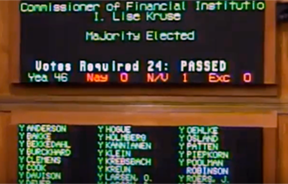Feb. 22, 2019 NASCUS Report
Posted February 22, 2019CFPB guide highlights payday payment issues
A guide highlighting the payment-related requirements of the CFPB’s “Payday Lending Rule” was released Wednesday, with a key disclaimer that the guide does not discuss the rule’s mandatory underwriting provisions – which the bureau is currently seeking to change in a proposed rule.
The bureau said its “small entity compliance guide” highlights information “that may be helpful when implementing the payment-related requirements of the Payday Lending Rule,” which the agency issued in October 2017.
However, just this month, the bureau proposed a change to the rule (which takes effect fully in August), which “reconsiders” (or rescinds) the portion of the rule requiring the mandatory underwriting provisions of the rule. The agency said, in releasing the guide Wednesday, that it “does not discuss the (existing) Rule’s mandatory underwriting provisions.”
The proposal to rescind the mandatory underwriting provisions is out for comment until May 15. In the meantime, the bureau is also proposing to delay the Aug. 19 compliance date for the mandatory underwriting by 15 months to Nov. 19, 2020. Comments are due on that by March 18.
The guide also pointedly notes that it is no substitute for reviewing the payday lending rule. “The Payday Lending Rule and its Official Interpretations (also known as the commentary) are the definitive sources of information regarding the Payday Lending Rule’s requirements,” the guide states.
CFPB said the guide also includes examples intended to illustrate some portions of the payday lending rule. However, the agency warned, the examples do not include all possible factual situations that could “illustrate a particular provision, trigger a particular obligation, or satisfy a particular requirement.”
In its section summarizing payment-related requirements of the rule (including what is a “covered loan”), the guide points out that certain accommodation and alternative loans that generally conform to requirements under NCUA’s Payday Alternative Loan (PAL) program are excepted from the rule’s requirements.
The guide also notes that there are eight other types of loans excluded as not “covered loans,” including (for example): perfected mortgage loans, credit card accounts, and “certain overdraft services and overdraft lines of credit.”
LINK:
Small Entity Compliance Guide: Payday Lending Rule
‘UNMODIFIED’ AUDIT OPINIONS ISSUED FOR OUR NCUA FUNDS
“Unmodified” audit opinions were earned by the four funds administered by NCUA late last week, making it the second federal financial institution regulator in as many days to announce so-called “clean” audit opinions.
NCUA said the four funds it administers earned the audit opinions. The agency’s Office of the Inspector General (OIG) released the results, which covered the National Credit Union Share Insurance Fund (NCUSIF), the agency’s operating fund, the Central Liquidity Facility, and the Community Development Revolving Loan Fund. The financial statements were audited by the independent auditor KPMG LLP.
More specifically, the reports noted that the NCUSIF (which held $15.8 billion in assets on Dec. 31, 2018) now protects the deposits of more than 115 million members at about 5,400 federally insured credit unions. According to the report, there were eight credit union failures last year, compared to 10 failures in 2017. The cost for 2018 (or the estimated cost of resolution at the time of liquidation, the report stated) was $785 million, compared to $24.4 million for 2017 failures.
Also last week, the Government Accountability Office (GAO) said the two funds administered by the FDIC – the Deposit Insurance Fund (DIF), and the Federal Savings and Loan Insurance Corp. (FSLIC) Resolution Fund (FRF) – received clean audit opinions, based on 2017 and 2018 financial statements. There were no bank failures in 2018, according to FDIC.
LINK:
NCUA’s Four Funds Receive Clean 2018 Audit Opinions
PRIVATELY INSURED CREDIT UNIONS SHOWED GROWTH IN ‘18
Privately insured, state-chartered credit unions posted some solid numbers at year-end 2018, with more than 6% asset growth, according to numbers compiled by NASCUS.
With just about two weeks to go until NCUA releases its year-end statistics for federally insured credit unions, the NASCUS-compiled numbers for the privately insured credit unions (PICUs) show the 114 privately insured credit unions hold just more than $17 billion in assets and count more than 1.3 million memberships (based on year-end call reports filed by the credit unions with American Share Insurance, the private share insurance option in the credit union industry).
Compared to year-end 2017, the PICUs grew in assets by 6.17% and expanded their memberships by 3.37%. The credit unions added just shy of $1 billion last year, and more than 43,000 members. Since 2015, the PICUs have expanded their assets by 14.4% (or $2.1 billion) and increased memberships by 4.7%.
The number of PICUs has fallen over that stretch, by just more than 8% (for 10 total) – which is in line with the consolidation of credit union numbers overall in a similar time period: between 2013-17, the number of federally insured credit unions dropped by 15%; from 2015-17, the total declined by 7.4%.
On average, at year-end 2018, a PICU held $149.4 million in assets and counted 11,500 memberships.
By comparison, according to figures released Thursday by the FDIC, banks and thrifts insured by the agency saw asset growth of 3.03% in 2018 (to a total of $17.9 trillion). Community banks, as a subset of all but 390 banks, reported asset growth of 2.3% to a total of $2.2 trillion, the bank insurer said. The average asset size is $453 million for the community banks, the FDIC numbers show.

The Senate vote tally for North Dakota Commissioner I. Lise Kruse shows solid backing for the regulator (click to see the video).
ND COMMISSIONER CONFIRMED FOR SEAT, AS YOUTUBE SHOWS …
What’s it like to be a state regulator? Well, for one thing, your name and position comes up in the state legislature from time-to-time for everyone to hear and see. That’s what happened recently for Lise Kruse, the commissioner of the North Dakota Department of Financial Institutions (NDDFI). Kruse has been serving as commissioner since December 2017, after former Commissioner Bob Entringer retired (after 35 years of service to the NDDFI). She was appointed by Gov. Doug Burgum (R). However, her confirmation to the position only became final earlier this month after a near-unanimous vote (there was one “not voting,” all others voted “yea,” resulting in a 46-0-1 tally) in the North Dakota state senate – which was captured for posterity in video posted to YouTube (click on the image above, or link below, to view). Kruse joined the department in 2004 as a financial institutions examiner; her most recent position was chief examiner of banks.
LINK:
Video: I. Lisa Kruse approved by ND state sentate, 46-0 (1 NV)

NASCUS’ Lucy Ito addresses North Dakota regulators and credit representatives during the North Dakota Legislative Credit Union Day this week in Bismarck.
… AS STATE SYSTEM MAKES ITS MARK IN THE NORTHERN PLAINS
Speaking of North Dakota: NASCUS President and CEO Lucy Ito on was hand in the Peace Garden State this week as credit union volunteers and professionals gathered in the state capital of Bismarck for Credit Union Association of the Dakotas (CUAD) annual North Dakota Legislative Credit Union Day. Ito offered a “State of the State Credit Union System” presentation, which (according to the CUAD) “proved to be a highlight for many attendees.” Others addressing the group included the afore-mentioned Lise Kruse, commissioner of the NDDFI.
ANY NASCUS EVENTS COMING UP IN APRIL? YOU BET!
As we head to the final week of February, spring (and April) is just around the corner – along with a full complement of educational events from NASCUS. Among the events coming:
- 2019 State Regulators’ National Meeting (April 1-3, National Harbor, MD); for regulators only, the program brings state credit union regulators from across the country for an intensive program that takes a deep dive into the issues, topics and trends resonating through the state credit union regulatory environment.
- CECL Symposium (April 10-11, Charlotte, NC); co-sponsored by NASCUS, the Carolinas Credit Union League and the North Carolina Credit Union Division, the two-day session focuses on the “current expected credit loss” (CECL) accounting standard for recognition and measurement of credit losses for loans and debt securities. The session provides an update of the current status of the standard and how credits unions can start their modeling process.
- NASCUS/CUNA BSA (April 23-24, Columbus, OH); a joint program of NASCUS, CUNA and the Ohio Department of Commerce. The program takes an in-depth look at issues related to topics that include marijuana business banking, money-service businesses (MSBs), cybersecurity, elder abuse, human trafficking, payments and enforcement actions. This two-day conference is followed later in the year (Nov. 18-21) by the BSA/AML Certification Conference in Tempe, Ariz. (also sponsored by NASCUS and CUNA).
- NASCUS 101 Member Orientation (April 25; webinar); a no-charge, one-hour event that brings together members, prospective members or anyone else interested in NASCUS (the voice of the state credit union system) to better understand the unique tools and benefits NASCUS offers. Attendees also hear from their peers—a member network of state regulators, credit unions, credit union leagues, and other system supporters—and how they leverage their NASCUS membership. The webinar ends with a Q&A session. Advance registration required.
For more about these events (including agendas and registration), or any other upcoming events at NASCUS, see our 2019 education agenda at the link below.
LINK:
NASCUS 2019 Education Agenda
BRIEFLY: Court sets date for FOM appeal; welcome Silver State Schools
April 16 is the date for oral arguments before a federal appeals court in a lawsuit brought by the banking industry against NCUA and its most recent field of membership regulation. The 9:30 a.m. hearing will be in the U.S. Court of Appeals for the D.C. Circuit in Washington. Last March, a U.S. district court judge vacated and set aside two provisions in NCUA’s new field of membership rules affecting the definition of local community and the population limits for rural districts. However, the same court also upheld two other areas in the rule challenged by the bankers: ability of credit unions to serve adjacent geographic areas, and allowing credit unions to serve areas in Core-Based Statistical Areas that do not include the core. NCUA and the American Bankers Association (ABA) are cross-appealing the district court’s decision … NASCUS welcomes Silver State Schools Credit Union, based in Las Vegas, Nev., as its newest member. The credit union holds $768 million in assets and counts 55,000 members; Scott Arkills is the president and CEO.
LINK:
Memorandum Opinion: ABA v. NCUA, March 29 ruling (FOM rules)
For more information about NASCUS's news and/or public relations, please contact our Marketing and Communications Department.